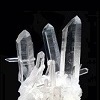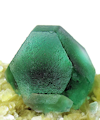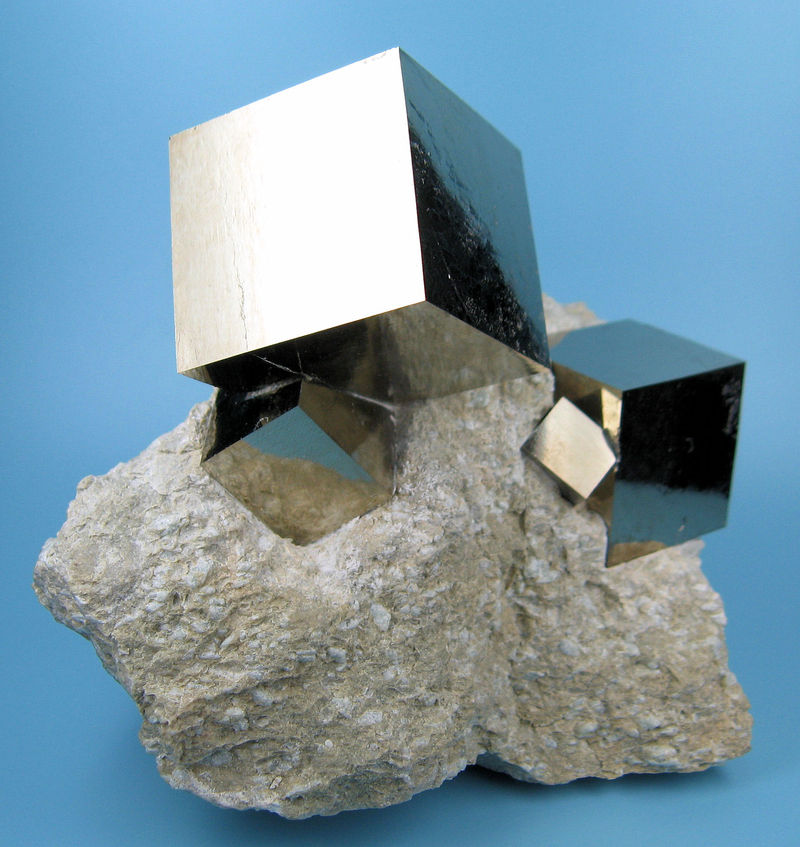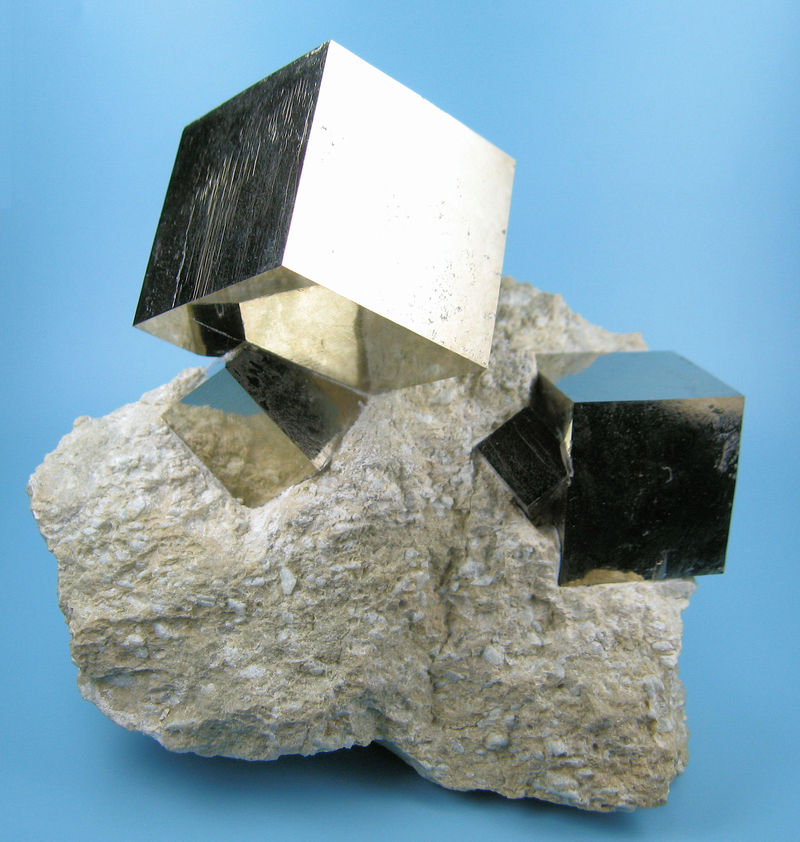| View previous topic :: View next topic |
| Author |
Message |
Casimir Sarisky
Joined: 14 Jun 2015
Posts: 56
Location: Maryland



|
 Posted: Aug 11, 2015 15:43 Post subject: The Behavior of Navajun Pyrite Cubes Posted: Aug 11, 2015 15:43 Post subject: The Behavior of Navajun Pyrite Cubes |
|
|
I rather curious about the nature of these Pyrites cubes from the Navajun, La Rioja area. Unlike other crystals these crystals are not tightly packed together on the matrix like other crystal formations I have seen online. Is there a reason why they are more spread apart from each other?
Also since these crystals are not tightly packed together like other formations, why are many single pyrite cubes have some nicks, contacts, or other damage along its edges and corners if it is far apart from any other crystals in the area. Is this the result of the effects of the weather or do these crystals naturally not form completely smooth edges and corners? And does this mean that they are no crystals without any damages whatsoever?
I am a bit interested in these specimens but I definitely do want to learn more about them. Especially since due to the process they often fall from the matrix when being extracted, requiring to be glued back onto the matrix itself.
|
|
| Back to top |
|
 |
yowanni
Joined: 27 Feb 2008
Posts: 37
Location: Spain (Cantabria / Madrid)



|
 Posted: Aug 12, 2015 01:21 Post subject: Re: The Behavior of Navajun Pyrite Cubes Posted: Aug 12, 2015 01:21 Post subject: Re: The Behavior of Navajun Pyrite Cubes |
|
|
| Casimir Sarisky wrote: | I rather curious about the nature of these Pyrites cubes from the Navajun, La Rioja area. Unlike other crystals these crystals are not tightly packed together on the matrix like other crystal formations I have seen online. Is there a reason why they are more spread apart from each other?
Also since these crystals are not tightly packed together like other formations, why are many single pyrite cubes have some nicks, contacts, or other damage along its edges and corners if it is far apart from any other crystals in the area. Is this the result of the effects of the weather or do these crystals naturally not form completely smooth edges and corners? And does this mean that they are no crystals without any damages whatsoever?
I am a bit interested in these specimens but I definitely do want to learn more about them. Especially since due to the process they often fall from the matrix when being extracted, requiring to be glued back onto the matrix itself. |
Hello Casimir,
In Navajún you can find single crystals or groups.
Most of the crystals are perfect, so damages along its edges and corners could be caused by the extraction process of the samples. And not all the crystals are glued.
I hope this will be useful for understand this mine.
Best regards,
Jonathan
|
|
| Back to top |
|
 |
Tobi
Site Admin

Joined: 07 Apr 2009
Posts: 4248
Location: Germany



|
 Posted: Aug 12, 2015 02:19 Post subject: Re: The Behavior of Navajun Pyrite Cubes Posted: Aug 12, 2015 02:19 Post subject: Re: The Behavior of Navajun Pyrite Cubes |
|
|
| A very informative website about those pyrites: https://www.piritasdenavajun.com/ (link normalized by FMF) (Available in Spanish AND English)
|
|
| Back to top |
|
 |
Carles Millan
Site Admin

Joined: 05 May 2007
Posts: 1537
Location: Catalonia



|
 Posted: Aug 12, 2015 13:00 Post subject: Re: The Behavior of Navajun Pyrite Cubes Posted: Aug 12, 2015 13:00 Post subject: Re: The Behavior of Navajun Pyrite Cubes |
|
|
First of all, pyrites from Navajún are not magmatic-hydrothermal but sedimentary. This is important to remember.
I guess (just guess) the pyrite crystals there grew prior to the marlstone matrix formation, which is a material rather soft and not very resistant to water. As yowanni well says, all or almost all of the crystals are perfect before being extracted. The damages are made by handling, especially when being separated from the matrix.
The adhesive force between pyrite faces and the matrix is almost non existent, so crystals are readily deattached. But many of the specimens offered for sale have them reattached with an efficient glue at the same place where they originally were. The vendor never hides this fact, but he prefers to say they are stabilized rather than glued.
Fortunately the deposit is far from exhausted, so expect Navajún pyrites in the market for well beyond our lifetime.
| Mineral: | Pyrite |
| Locality: | | Ampliación a Victoria Mine, De Alcarama Range, Navajún, Comarca Cervera, La Rioja, Spain |  |
|
| Dimensions: | 95 mm x 78 mm. Main crystal: 52 mm wide, 31 mm on edge. Weight: 512 g |
| Description: |
| Four undamaged cubic pyrite crystals with mirror-like faces intergrown on a matrix of marlstone (some people claim it to actually be limolite). Field collected in spring 2007. |
|
| Viewed: |
19839 Time(s) |

|
| Locality: | | Ampliación a Victoria Mine, De Alcarama Range, Navajún, Comarca Cervera, La Rioja, Spain |  |
|
| Dimensions: | 95 mm x 78 mm. Main crystal: 52 mm wide, 31 mm on edge. Weight: 512 g |
| Description: |
| Four undamaged cubic pyrite crystals with mirror-like faces intergrown on a matrix of marlstone (some people claim it to actually be limolite). Field collected in spring 2007. |
|
| Viewed: |
14970 Time(s) |

|
|
|
| Back to top |
|
 |
Ivan Blanco (PDM)
Joined: 14 Apr 2012
Posts: 33
Location: Antwerp, Belgium



|
 Posted: Aug 12, 2015 14:37 Post subject: Re: The Behavior of Navajun Pyrite Cubes Posted: Aug 12, 2015 14:37 Post subject: Re: The Behavior of Navajun Pyrite Cubes |
|
|
...well, I would say that according to the published papers available in the bibliography pyrites from Soria - La Rioja, where the well known deposits of Valdeperillo, Ambas Aguas or Navajún are located, are developed by hydrothermal metamorphism, with temperatures of formation above 200°C. The "purity" or the lack of defects or even the morphology (cube, dodecahedron, or combinations, etc.) are controlled by diferences in temperature of formation (ussualy between 300°C and 375°C) and the supersaturation.
Some papers explaining this are listed bellow. They are available for free via researchgate(.)net:
- Pathways and distances of fluid flow during low-grade metamorphism: evidence from pyrite deposits of the Cameros Basin, Spain (1999). Joumal of Metamorphic Geology 17: 339-348. J. ALONSO-AZCARATE, M. RODAS, S. H. BOTTRELL, R. RAISWELL, F. VELASCO, J. R. MAS.
- Causes of variation in crystal morphology in metamorphogenic pyrite deposits of the Cameros Basin (N Spain). (2001). Geological Journal 36(2):159 - 170. J. ALONSO-AZCÁRATE; M.RODAS; L. FERNÁNDEZ-DíAZ; S.H. BOTTREL; J.R.MAS; S.LÓPEZ-ANDRÉS. via: https://eprints.ucm.es/10586/1/Causes_of_variaton_in_crystal.pdf (link normalized by FMF)
_________________
Iván
I collect pseudomorphs |
|
| Back to top |
|
 |
Casimir Sarisky
Joined: 14 Jun 2015
Posts: 56
Location: Maryland



|
 Posted: Aug 12, 2015 16:54 Post subject: Re: The Behavior of Navajun Pyrite Cubes Posted: Aug 12, 2015 16:54 Post subject: Re: The Behavior of Navajun Pyrite Cubes |
|
|
Thanks for the responses. To be quite honest, I am not familiar with much of the geological terminology used by the links submitted here, so I really cannot understand them to be honest.
Johnathan and Carles, you provided the responses that I can understand myself. It makes sense to me understanding the basics of mining this mineral from the matrix. At first I thought the non-perfect edges and corners were the result of a crystal not completed formed, but I now understand it is the result of miners trying to extract the crystal and its surrounding matrix from the ground.
Carles I must say that Navajun specimen is quite beautiful! I hope to acquire one of my own someday. I am glad the mining area has plenty more specimens to be discovered. :)
|
|
| Back to top |
|
 |
Carles Millan
Site Admin

Joined: 05 May 2007
Posts: 1537
Location: Catalonia



|
|
| Back to top |
|
 |
Carles Millan
Site Admin

Joined: 05 May 2007
Posts: 1537
Location: Catalonia



|
|
| Back to top |
|
 |
Peter Megaw
Site Admin

Joined: 13 Jan 2007
Posts: 973
Location: Tucson, Arizona



|
 Posted: Aug 14, 2015 11:12 Post subject: Re: The Behavior of Navajun Pyrite Cubes Posted: Aug 14, 2015 11:12 Post subject: Re: The Behavior of Navajun Pyrite Cubes |
|
|
Thanks for this thread guys...it has stimulated my digging into some of the references and learn about the genesis of Pedro's great pyrites. They are not hydrothermal in the sense of being formed from high temperature fluids associated with a magmatic ore system...which is where the groups of tightly intergrown pyrites we're used to seeing come from. However, although they form in sedimentary rocks and the ingredients to make the pyrite appear to be derived from those sedimentary rocks, they required a more regional metamorphic heating event to flush hot fluids (probably formation waters...water trapped between the sedimentary grains as the muds and sands were laid down) through the rocks and reformulate the iron and sulfur into pyrite. Pyrite is strongly "idiomorphic" meaning it has the ability to form sharp crystals within essentially occupied space...it pushes the surrounding materials away as it grows, allowing perfect crystals to form. I suspect that these formed early in the metamorphic event before the carbonate muds that make marl were fully lithified. Pyrite formed during "diagenesis" (the conversion of sediments to rock) is very common and this looks like a supercharged version of this accelerated and assisted by the metamorphic event which simultaneously heated the formation waters and drove them through the sedimentary section with flow concentrated in the more permeable beds.
_________________
Siempre Adelante! |
|
| Back to top |
|
 |
|





